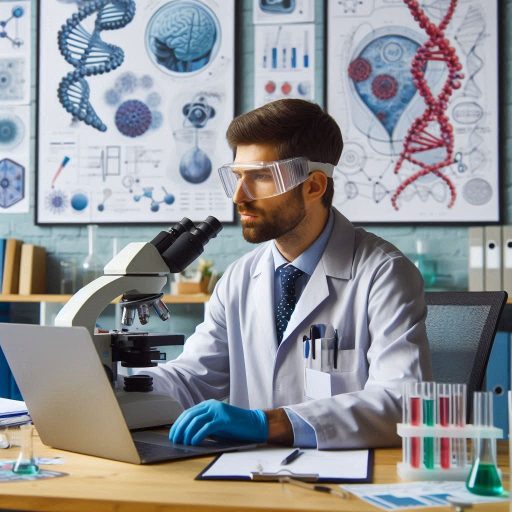Introduction
Bioinformatics is an interdisciplinary field that merges biology, computer science, and statistics to analyze biological data.
It focuses on managing and interpreting complex datasets, particularly in genomics and molecular biology.
Bioinformatics plays a crucial role in understanding genetic information and biological processes.
In genomics, bioinformatics helps researchers analyze DNA sequences, identify genes, and study genetic variations.
This information is essential for understanding hereditary diseases and developing gene therapies.
In healthcare, bioinformatics enables personalized medicine by tailoring treatments based on individual genetic profiles.
It enhances drug development and supports disease diagnosis by analyzing patient data.
The biotechnology sector also relies on bioinformatics for research and product development.
It aids in designing experiments and analyzing results, leading to more efficient processes and innovations.
Bioinformatics applications improve agricultural practices by analyzing plant genomes and developing resistant crop varieties.
As the need for data-driven solutions grows, so does the demand for bioinformaticians.
Industries require skilled professionals to analyze complex biological datasets and develop computational tools.
Job opportunities in this field are increasing, with positions available in academia, healthcare, pharmaceuticals, and biotechnology companies.
Bioinformaticians play a vital role in advancing scientific research and improving health outcomes, making their expertise increasingly valuable.
Role of a Bioinformatician
Analyzing and Interpreting Biological Data
A bioinformatician plays a crucial role in analyzing and interpreting biological data.
They examine vast datasets generated from experiments like DNA sequencing and protein studies.
By organizing this data, bioinformaticians enable researchers to extract meaningful insights.
They identify patterns, trends, and relationships within the biological data.
This process helps in understanding complex biological systems and phenomena.
Bioinformaticians also use various software tools to assist in data analysis.
They employ techniques such as data mining and visualization to present their findings.
These visual representations make it easier for researchers to grasp complex information.
Bioinformaticians ensure that the data is reliable and accurately interpreted, which is critical for subsequent research and applications.
Developing Algorithms and Computational Tools for Data Analysis
Developing algorithms and computational tools is another essential responsibility of bioinformaticians.
They create innovative algorithms tailored to specific biological questions.
These algorithms help streamline data processing and analysis, enhancing efficiency.
For instance, a bioinformatician might develop a tool to identify genetic variants associated with diseases.
By building custom software solutions, bioinformaticians address unique challenges in biological research.
They apply programming languages like Python, R, and Java to design these tools.
Moreover, bioinformaticians continually update and refine their algorithms to keep pace with evolving scientific needs.
This ongoing development is vital for improving the accuracy and relevance of biological analyses.
Using Statistical Methods to Draw Conclusions from Large Datasets
Bioinformaticians utilize statistical methods to draw conclusions from large datasets.
They apply techniques such as regression analysis, clustering, and hypothesis testing.
These methods help in making sense of complex biological information and extracting actionable insights.
By analyzing the data statistically, bioinformaticians can identify significant findings that might otherwise go unnoticed.
Bioinformaticians validate their conclusions through rigorous testing and verification.
They ensure that the statistical methods used are appropriate for the data at hand.
This validation process strengthens the reliability of their findings and supports further research efforts.
Collaborating with Biologists, Geneticists, and Other Scientists
Collaboration is a key aspect of a bioinformatician’s role.
They work closely with biologists, geneticists, and other scientists to solve biological problems.
This interdisciplinary teamwork is essential for integrating computational analysis with biological insights.
By combining their expertise, bioinformaticians and researchers can tackle complex questions in biology and medicine.
Bioinformaticians facilitate communication between computational and biological scientists.
They help translate biological questions into computational problems that can be solved with data analysis.
This collaboration fosters a deeper understanding of biological processes and enhances research outcomes.
Moreover, bioinformaticians often participate in research projects and contribute to publications.
They provide valuable insights that inform experimental designs and help interpret results.
This teamwork ultimately drives advancements in fields such as genomics, proteomics, and systems biology.
Bioinformaticians play a vital role in modern biological research.
They analyze and interpret biological data, develop computational tools, and apply statistical methods.
Their collaboration with other scientists enriches the research process and drives innovation.
As the field of bioinformatics continues to evolve, bioinformaticians will remain essential for bridging the gap between data and biological understanding.
Their work significantly impacts healthcare, agriculture, and environmental science, underscoring the importance of this career path.
Read: Profiles in Success: Leading Chemists of the 21st Century in the US
Job responsibilities of a bioinformatician
Designing and Implementing Data Analysis Pipelines
One of the primary responsibilities of a bioinformatician is designing data analysis pipelines.
These pipelines streamline the processing of large biological datasets.
They enable efficient data handling, transformation, and analysis, ensuring reproducibility and accuracy.
Bioinformaticians select appropriate tools and software for each project.
They often customize existing algorithms or develop new ones to meet specific research needs.
This requires a solid understanding of both biological processes and computational methods.
Bioinformaticians test and validate their pipelines.
They ensure that the methods produce reliable results, which is vital for downstream applications.
By continuously refining these processes, they enhance the quality of scientific research.
Identifying Patterns and Trends in Biological Data
Bioinformaticians excel at identifying patterns and trends in complex biological data.
They analyze genomic, proteomic, and metabolomic datasets to uncover insights.
This process often involves statistical analyses and machine learning techniques.
By identifying these patterns, bioinformaticians can help researchers understand biological phenomena.
For instance, they may discover genetic variations associated with diseases.
These insights can lead to breakthroughs in personalized medicine and treatment strategies.
In addition, bioinformaticians collaborate with biologists and clinicians to interpret their findings.
Their ability to translate complex data into understandable results fosters interdisciplinary collaboration.
This collaboration can ultimately drive innovative solutions in healthcare and research.
Writing Research Papers and Reports to Communicate Findings
Effective communication is a vital aspect of a bioinformatician’s role.
They write research papers and reports to communicate their findings clearly.
These documents are essential for sharing knowledge with the scientific community.
Bioinformaticians summarize their methodologies, results, and interpretations in these papers.
They must adhere to scientific writing standards, ensuring clarity and precision.
This skill is crucial for publishing in peer-reviewed journals and presenting at conferences.
Furthermore, bioinformaticians often create visualizations to illustrate their findings.
Graphs, charts, and diagrams help convey complex information effectively.
Well-crafted visuals enhance understanding and make research accessible to broader audiences.
Keeping Up-to-Date with the Latest Developments in Bioinformatics and Computational Biology
Bioinformatics is a rapidly evolving field.
To remain effective, bioinformaticians must stay updated on the latest developments.
They regularly read scientific literature, attend conferences, and participate in workshops.
By keeping current, bioinformaticians can incorporate new tools and techniques into their work.
They can also learn about emerging trends and technologies in computational biology.
This ongoing education enhances their ability to contribute to innovative research.
Networking with other professionals in the field is also beneficial.
Collaborating with peers can spark new ideas and foster the exchange of knowledge.
This collaborative spirit is essential for advancing bioinformatics and its applications.
Bioinformaticians play a vital role in the life sciences.
They design data analysis pipelines, identify patterns in biological data, and communicate their findings effectively.
Staying up-to-date with developments in bioinformatics ensures they remain at the forefront of scientific innovation.
Their contributions significantly advance our understanding of biological processes and improve healthcare outcomes.
Read: The Life and Times of a U.S. Physicist: A Day in Detail
Skills required to become a successful bioinformatician
Proficiency in Programming Languages
A bioinformatician must be proficient in programming languages like Python, R, and Perl.
These languages are essential for data manipulation and analysis.
Python is popular for its simplicity and versatility.
Bioinformaticians use Python to write scripts that automate data processing tasks.
R is widely used for statistical analysis and data visualization.
Bioinformaticians leverage R’s extensive libraries for bioinformatics applications.
Perl, although less common today, remains useful for text processing and handling biological data formats.
Proficiency in these languages allows bioinformaticians to efficiently analyze complex datasets.
Additionally, familiarity with SQL enhances their ability to manage and query databases.
Bioinformaticians often work with large datasets stored in relational databases.
Strong programming skills enable them to develop custom tools and software for specific research needs.
Strong Background in Statistics and Mathematics
A solid understanding of statistics and mathematics is crucial for bioinformaticians.
They apply statistical methods to analyze and interpret biological data.
Knowledge of probability, regression analysis, and hypothesis testing is essential.
Bioinformaticians use statistical techniques to validate experimental results.
They help ensure that findings are robust and reliable.
For instance, they may conduct power analyses to determine the sample size needed for studies.
Mathematical modeling is also important in bioinformatics.
Bioinformaticians often create models to simulate biological processes.
These models help researchers understand complex interactions within biological systems.
A strong foundation in statistics and mathematics empowers bioinformaticians to derive meaningful conclusions from their analyses.
Knowledge of Biological Concepts and Data Analysis Techniques
Bioinformaticians must possess a solid understanding of biological concepts.
Familiarity with genetics, molecular biology, and genomics is vital.
This knowledge enables them to interpret data in a biological context effectively.
They analyze various data types, including genomic sequences and protein structures.
Understanding the significance of these data types informs their analysis strategies.
Bioinformaticians also utilize bioinformatics tools and databases to access relevant information.
Proficiency in data analysis techniques is essential for bioinformaticians.
They apply machine learning and data mining methods to extract patterns from large datasets.
These techniques help identify correlations and associations that inform biological research.
Ability to Work in a Multidisciplinary Team
Bioinformaticians often collaborate in multidisciplinary teams.
They work alongside biologists, chemists, and clinicians to achieve common goals.
Effective communication is crucial for successful collaboration in these diverse teams.
Bioinformaticians must explain complex concepts to colleagues without technical backgrounds.
They should convey findings and insights clearly and concisely.
This ability fosters collaboration and helps teams make informed decisions based on data analysis.
Teamwork is essential for conducting research in modern laboratories.
Bioinformaticians contribute unique perspectives and skills that enhance the overall research process.
Their collaborative efforts lead to innovative solutions in areas such as drug discovery and disease understanding.
In essence, bioinformaticians play a vital role in advancing biological research.
Their proficiency in programming languages, strong background in statistics, and knowledge of biology enable them to analyze complex data.
Their ability to work in multidisciplinary teams enhances collaboration and drives innovation.
As the field of bioinformatics continues to evolve, the demand for skilled professionals will remain high.
Read: Salary Ranges: What to Expect as a Physicist in the USA

Educational Requirements for a Career in Bioinformatics
Bachelor’s Degree in Bioinformatics or Related Fields
A career as a bioinformatician typically begins with a bachelor’s degree.
Students can pursue degrees in bioinformatics, computational biology, computer science, or related fields.
These programs provide a strong foundation in biology and computational skills.
Coursework usually includes subjects like genetics, molecular biology, and data analysis.
During their undergraduate studies, students often learn programming languages such as Python and R.
They also gain experience with databases and statistical analysis.
Many programs offer practical projects or internships, allowing students to apply their knowledge in real-world scenarios.
Hands-on experience is crucial for understanding how to analyze biological data effectively.
Graduates can find entry-level positions in research laboratories, healthcare organizations, or biotech companies.
Job roles may include data analyst, research assistant, or software developer.
These positions help individuals gain valuable experience and further develop their skills in bioinformatics.
Master’s or Ph.D. for Advanced Research Positions
Pursuing a master’s degree or Ph.D. in bioinformatics opens doors to advanced research positions.
Many employers prefer candidates with advanced degrees for roles in academia or industry research.
Graduate programs offer specialized training in areas like genomics, proteomics, and systems biology.
Master’s programs often involve coursework combined with research projects.
Students gain in-depth knowledge of advanced bioinformatics tools and techniques.
They learn to conduct independent research, analyze complex datasets, and interpret results effectively.
Ph.D. programs focus on original research and typically require a dissertation.
Doctoral candidates contribute new knowledge to the field of bioinformatics.
Graduates often pursue careers as research scientists, faculty members, or industry leaders.
Advanced degrees equip bioinformaticians with the skills needed for cutting-edge research and leadership roles.
Continuing Education and Professional Development
Bioinformatics is a rapidly evolving field.
Therefore, continuing education and professional development are essential for bioinformaticians.
Staying current with the latest advancements ensures they remain competitive in the job market.
Many professionals pursue additional certifications, workshops, or online courses.
These opportunities help them learn new software tools, programming languages, and data analysis techniques.
Participating in conferences and seminars fosters networking and collaboration with peers in the field.
Bioinformaticians can also engage in professional organizations, such as the International Society for Computational Biology.
Membership provides access to resources, training opportunities, and the latest research findings.
Moreover, many employers support continuing education by offering training programs.
These programs help employees acquire new skills relevant to their roles.
Ongoing learning encourages professional growth and job satisfaction.
A career as a bioinformatician requires a strong educational foundation.
A bachelor’s degree in bioinformatics or a related field is essential for entry-level positions.
Pursuing a master’s or Ph.D. opens opportunities for advanced research roles.
Continuous education and professional development are vital for staying current in this dynamic field.
By investing in their education and skills, bioinformaticians can contribute to significant advancements in healthcare and biological research.
The future of bioinformatics holds exciting possibilities for those passionate about the intersection of biology and technology.
Read: Physics Specializations: Choosing Your Path in the U.S.
Transform Your Career Today
Unlock a personalized career strategy that drives real results. Get tailored advice and a roadmap designed just for you.
Start NowCareer paths for bioinformaticians
Research Scientists in Academic Institutions or Government Agencies
Research scientists in bioinformatics typically work in academic institutions or government agencies.
They conduct fundamental research that advances our understanding of biological systems.
These scientists analyze complex biological data, such as genomic sequences and protein structures.
In academic settings, they often collaborate with other researchers on interdisciplinary projects.
They publish findings in scientific journals and present at conferences.
This sharing of knowledge fosters collaboration and innovation within the field.
Government agencies employ bioinformatics researchers to support public health initiatives.
These scientists may analyze data related to infectious diseases or genetic disorders.
Their work often informs policy decisions and public health strategies.
Research scientists also supervise graduate students and postdoctoral researchers.
They mentor the next generation of bioinformaticians and contribute to academic programs.
This mentoring role is vital for training skilled professionals in the field.
Data Scientists in Biotech Companies or Pharmaceutical Firms
Data scientists play a crucial role in biotech companies and pharmaceutical firms.
They focus on analyzing large datasets generated from experiments and clinical trials.
Their work helps accelerate drug discovery and development processes.
These professionals use advanced statistical methods and machine learning techniques.
They develop algorithms that can predict drug responses and identify potential side effects.
Their analyses support the design of clinical trials and enhance drug efficacy.
Data scientists also collaborate with biologists and chemists.
This collaboration ensures that data-driven insights align with experimental goals.
Together, they can optimize research efforts and improve overall project outcomes.
Data scientists are responsible for visualizing complex data.
They create dashboards and reports that make insights accessible to stakeholders.
Effective communication of data findings is essential for informed decision-making.
Bioinformatics Consultants for Healthcare Organizations or Research Labs
Bioinformatics consultants provide specialized expertise to healthcare organizations and research labs.
They help implement bioinformatics tools and strategies tailored to specific needs.
These consultants often assess existing data infrastructure and recommend improvements.
Consultants also train staff on using bioinformatics software and tools.
They ensure that healthcare professionals can effectively analyze and interpret biological data.
This training enhances the organization’s capacity to leverage bioinformatics in their operations.
In addition, bioinformatics consultants may work on specific projects.
They might assist in analyzing patient genomic data to inform personalized treatment plans.
Their expertise helps healthcare organizations make data-driven decisions.
Moreover, consultants stay updated on the latest bioinformatics advancements.
They bring innovative solutions and best practices to their clients, enhancing research capabilities.
This ongoing learning is vital for maintaining a competitive edge in the field.
University Professors or Instructors in Bioinformatics Programs
University professors and instructors play a critical role in bioinformatics education.
They teach courses that cover topics such as genomics, data analysis, and computational biology.
Their instruction prepares students for careers in bioinformatics and related fields.
Professors also conduct their own research, contributing to the advancement of bioinformatics.
They often secure grants to fund innovative projects and studies.
This research enhances the learning experience for students by integrating practical applications.
University faculty members mentor students and guide their research projects.
They help students develop essential skills for success in the bioinformatics field.
This mentorship fosters a supportive academic environment.
Professors may also collaborate with industry partners on research initiatives.
These collaborations can lead to internships and job opportunities for students.
This connection between academia and industry is vital for workforce development.
Bioinformaticians occupy diverse roles in various settings.
Research scientists, data scientists, consultants, and educators all contribute significantly to the field.
Each role offers unique opportunities to advance biological research and healthcare applications.
Salary and Job Outlook for Bioinformaticians
Median Salary for Bioinformaticians
Bioinformaticians enjoy a competitive median salary of around $85,000 per year.
This figure can vary based on experience, education, and geographic location.
Entry-level bioinformaticians typically earn less than the median salary.
However, with experience and advanced skills, salaries can significantly increase.
Many factors influence salary levels in bioinformatics.
For instance, professionals with advanced degrees often command higher salaries.
Specialized skills in programming, data analysis, or specific software tools can also boost earnings.
Those working in pharmaceutical companies or research institutions may earn more than those in academia.
Benefits can also enhance overall compensation packages.
Many employers offer health insurance, retirement plans, and paid time off.
Some organizations provide additional perks, such as professional development opportunities and flexible working hours.
These factors make bioinformatics an attractive career choice for many professionals.
Job Growth Rate of 15% Expected in the Next Decade
The bioinformatics field is experiencing significant growth, with a projected job growth rate of 15% in the next decade.
This growth is driven by the increasing demand for data analysis in healthcare and life sciences.
As technology advances, the need for skilled bioinformaticians will continue to rise.
Many industries are seeking bioinformaticians to help analyze large datasets.
These include biotechnology firms, pharmaceutical companies, and academic research institutions.
The rise of personalized medicine and genomics research further fuels demand for bioinformatics expertise.
As more organizations recognize the value of bioinformatics, job opportunities will expand.
Moreover, healthcare organizations are increasingly leveraging bioinformatics for data-driven decision-making.
This trend creates more roles for professionals skilled in analyzing biological data.
As healthcare becomes more data-centric, bioinformaticians will play a crucial role in shaping the future of medicine.
Opportunities for Advancement and Specialization
Bioinformatics offers numerous opportunities for advancement and specialization.
Professionals can focus on areas such as genomics, drug discovery, or personalized medicine.
Specializing in a specific area enhances career prospects and increases earning potential.
In genomics, bioinformaticians analyze genetic data to identify disease markers.
This specialization plays a vital role in advancing genetic research and therapies.
Bioinformaticians in drug discovery work closely with pharmaceutical companies to analyze data for new drug candidates.
They contribute to the development of targeted therapies, improving treatment outcomes for patients.
Personalized medicine is another exciting area of specialization.
Bioinformaticians in this field use genetic information to tailor treatments to individual patients.
This approach enhances the effectiveness of therapies and minimizes side effects.
As personalized medicine becomes more mainstream, demand for specialists will increase.
Advancement opportunities are also available for bioinformaticians.
With experience, professionals can move into leadership roles, managing teams and projects.
They may also transition into research management or consultancy positions.
Continued education and professional development can facilitate these advancements.
Bioinformatics offers a promising career path with competitive salaries and strong job growth.
The median salary of around $85,000 reflects the value of bioinformaticians in today’s data-driven landscape.
As the field evolves, opportunities for specialization and advancement will continue to grow.
Bioinformaticians will play an essential role in shaping the future of healthcare and research.
Conclusion
A bioinformatician plays a crucial role in analyzing biological data and interpreting complex information.
In this blog post, we summarized the key responsibilities of bioinformaticians, including data analysis, software development, and algorithm creation.
These professionals work at the intersection of biology and computer science, making significant contributions to research and healthcare.
Bioinformaticians can pursue diverse career opportunities in various sectors.
They can work in academic research, pharmaceutical companies, or healthcare organizations.
Some focus on genomics, while others specialize in proteomics or systems biology.
This variety allows bioinformaticians to tailor their careers to their interests and skills.
The demand for bioinformaticians continues to grow, driven by advancements in technology and the increasing need for data analysis in life sciences.
As a result, professionals in this field enjoy a rewarding and dynamic work environment.
We encourage readers to consider a career in bioinformatics.
This profession offers unique challenges and opportunities to impact healthcare and research significantly.
By pursuing a career in bioinformatics, you can engage in groundbreaking projects and contribute to the future of medicine.
Join this exciting field, and be part of the innovation shaping tomorrow’s healthcare landscape.




